Every country has its own particular energy. The same goes for every city. There are places in this world with which I resonate and others that disrupt my energy flow. In spite of the fact that it was a lovely city, Zurich was one of those places that sapped me completely and I was anxious to leave. The question was, to where? I ‘d been reading the Swiss tourism brochures and there were a wealth of places that seemed like interesting destinations, so I packed my bags, walked the few blocks to the train station and looked up at the big board that shows where all the trains are going. Eeny, meeny, miney, moe – I chose the train to Lucerne that was leaving in four minutes. Less than an hour later I arrived at the Lucerne Bahnhof – the main train station, and headed for the Hotel Alpha, which I found in the Swiss Backpacker News magazine.
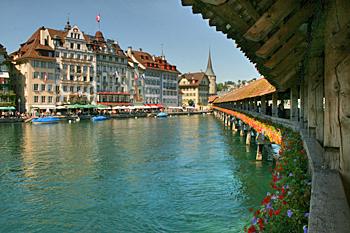
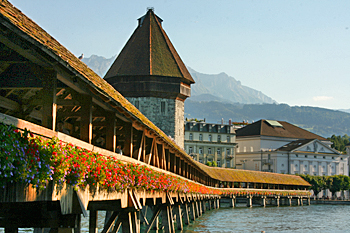
The Hotel Alpha is a really nice budget hotel/backpacker guesthouse – certainly it makes my list of the top three places I have stayed on this trip. Like all backpacker lodges, the room has no private toilet or shower – the toilets and showers are shared facilities on each floor. However, each room has a sink with hot and cold water; a comfortable bed with a good mattress covered by a thick, fluffy duvet; and fresh towels each day. There are guest lounges with share/swap libraries, TV, and Internet and the place is absolutely spotless. Best of all the staff at the Alpha is wonderful, unlike the rude people at Hotel Martahaus in Zurich.
From the moment I stepped off the train I could feel the shift in energy – Lucerne was going to be a good place for me. After settling into my room, I walked the few blocks to the city center and began exploring what to do in Lucerne Switzerland by walking across the Reuss River via Lucerne’s famous Chapel Bridge, the oldest wooden bridge in Europe and the most photographed monument in Switzerland. This covered wooden bridge was originally built in 1333 and after nearly burning down in 1993, was reconstructed true to the original. Adjoining the bridge is an octagonal stone water tower, which has served as a prison, torture chamber, watchtower and treasury. Behind the bridge and the water tower looms lofty Mount Pilatus, a 7000-foot high massif that is steeped in legends of dragons and evil spirits that are said to haunt its slopes and live in its lakes.
On the other side of the bridge lay the Old City of Lucerne, an area of narrow, stone paved streets with names like Hirschenplatz, Weinmarkt Square, and Kornmarkt Square, the latter featuring the beautifully preserved Town Hall:



At every turn I encountered historic fresco-painted houses, some with murals depicting historic events and others painted to mimic faux brick and capstones:
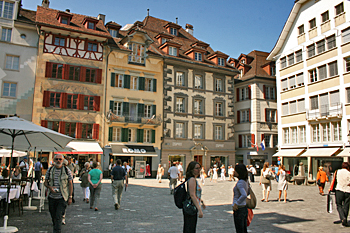
The end of Kappelgasse Street ended opened onto Schwanenplatz, a wide square, across which I got my first glimpse of Lake Lucerne. Crossing over to the shore, I sat on the edge of the concrete sidewalk and dangled my feet over the embankment, watching giant swans bicker over who was entitled to the chunks of bread being tossed into the water. Lake Lucerne is a deep blue, reminiscent of Wedgewood China. The perpetually snow-covered peaks of the Alps lie to the southeast and provide an exquisite backdrop for the crystal blue of the lake. Sailboats drift lazily along, an occasional speedboat tows skiers, and dozens of rent-by-the-hour paddle boats ply the waters as well.
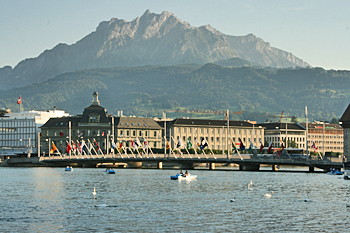
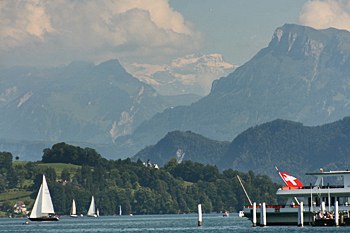
Regularly scheduled paddle-wheel steamboats carry passengers to destinations along the lake, blowing their foghorns whenever one of the smaller vessels gets into their path. It was serene and peaceful and I sat there for the longest time, just drinking it all in while contentment poured through every cell in my body.

When I could finally pull myself away from this idyllic scene, I set about discovering the other sites of Lucerne. Among the most magnificent examples of the city’s architecture are its churches, the most notable being the Jesuit Church, here seen from across the river:

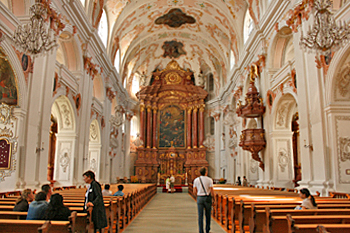
and the Hof Church, viewed from the other side of the lake, with its twin spires mirrored in the reflecting pond of the city’s Art Museum:
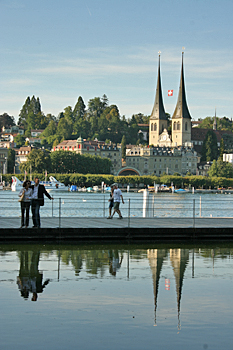
At the end of the reflecting pond a fountain thrust towers of water into the air, the mist from the churning water catching the late afternoon sun to form a rainbow:

I headed up further into the hills bordering the lake to see the Dying Lion of Lucerne. Hewn out of the natural rock of the hillside, this monument memorializes the heroic death of Swiss mercenaries at the Tuileries in 1792. Globetrotter Mark Twain once described The Dying Lion of Lucerne as “the saddest and most moving piece of rock in the world.”
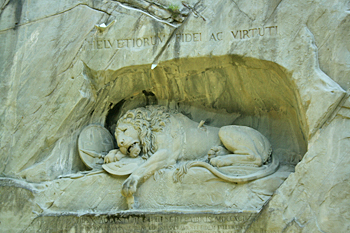
I continued up the hillside to view the Musegg Wall, a remaining portion of the rampart walls built to protect the city in 1386. The wall and its towers are in remarkably good shape – three of them are open to the public and allow access to the ramparts, which provide nice views of the city and lake below.

When the sun began to set at 9 PM I descended from the hillside into the Old City. Music wafted up from below and I followed the sound through the narrow lanes until I discovered its source. In the Town Hall courtyard, a group of musicians had set up their Alphorns in a semicircle on the courtyard.
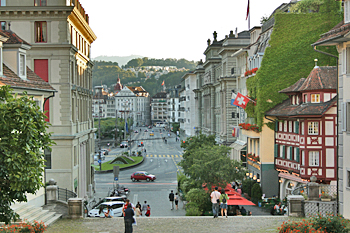
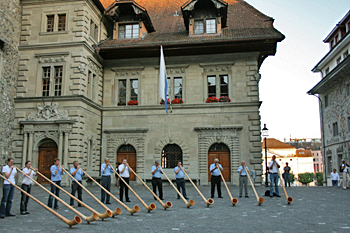
These wooden horns are about ten feet long and curve up at the end, thus the horn portion rest on the ground while the musicians hold the mouthpiece up to their lips. The sound is like no other instrument I have ever heard. It is deep but not as deep as a tuba. It produces a sound that is strong yet somehow soft and gentle as well. It reminded me most of sitting in a temple in Thailand and listening to scores of monks chant ritual Buddhist verses. I got goosebumps; the hair on the back of my neck stood up; I had a moment of crystal clarity about the meaning of life.
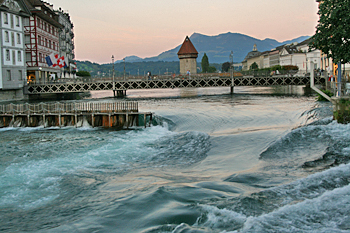
When the performance was finished, I floated down the stairs to the Reuss River at the point where the water spikes regulate the level of the water and watched as the setting sun turned the rapids pink. What a perfect ending to this most excellent of days.

I have visited Lucerne on our annual 7-day school trip to Switzerland & Italy, 9 years ago and I have to say it is one of the most peaceful cities I have ever visited in my life! I guess I could easily live there forever!
Barbara,
How beautiful to read/see that you were ‘in the now’. No one can ‘find’ happiness, it finds you; when one is at peace and when one is content.
Thank you.